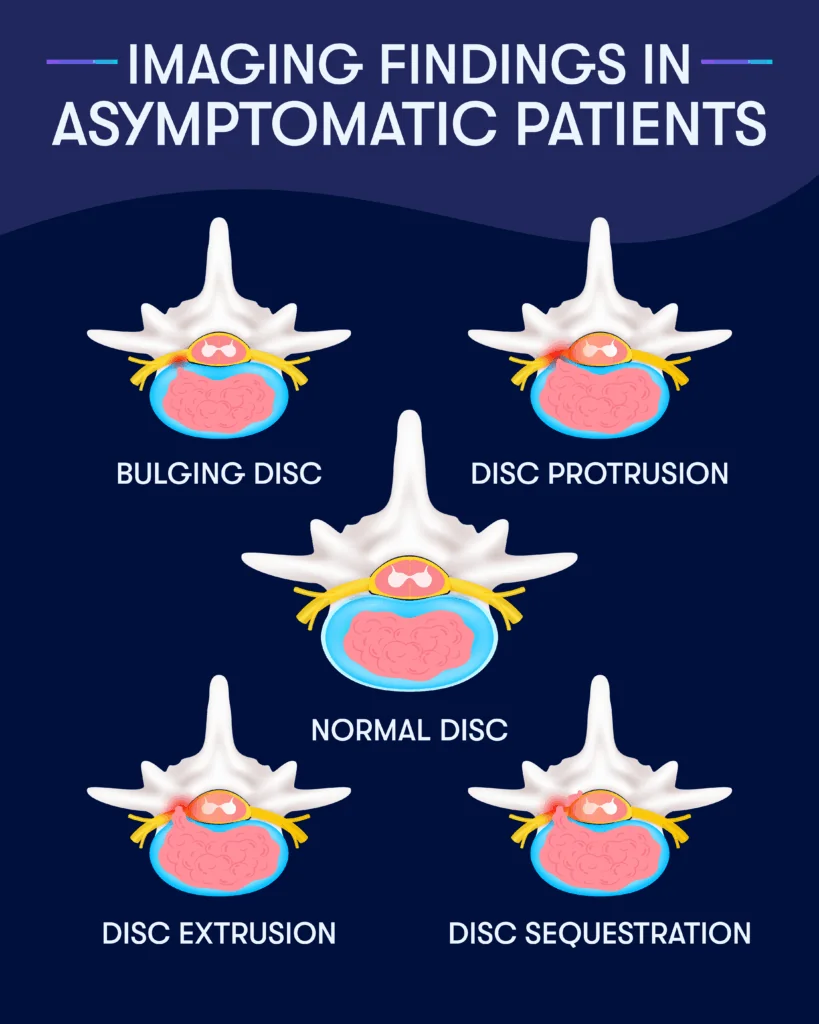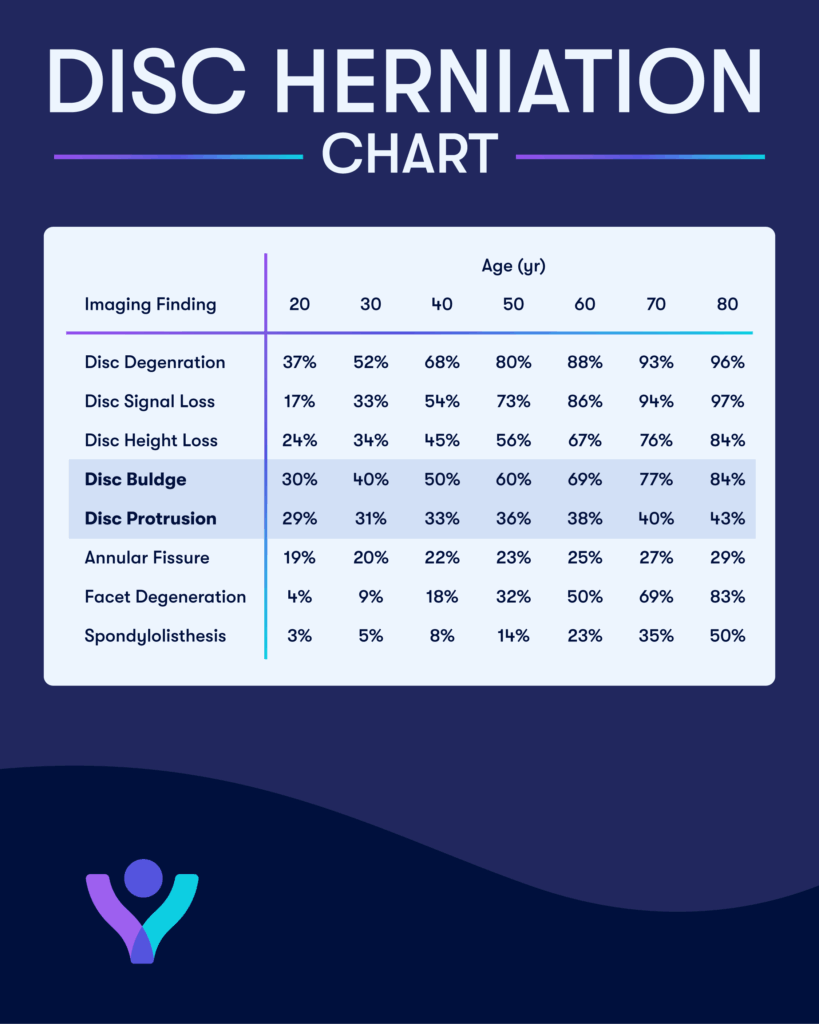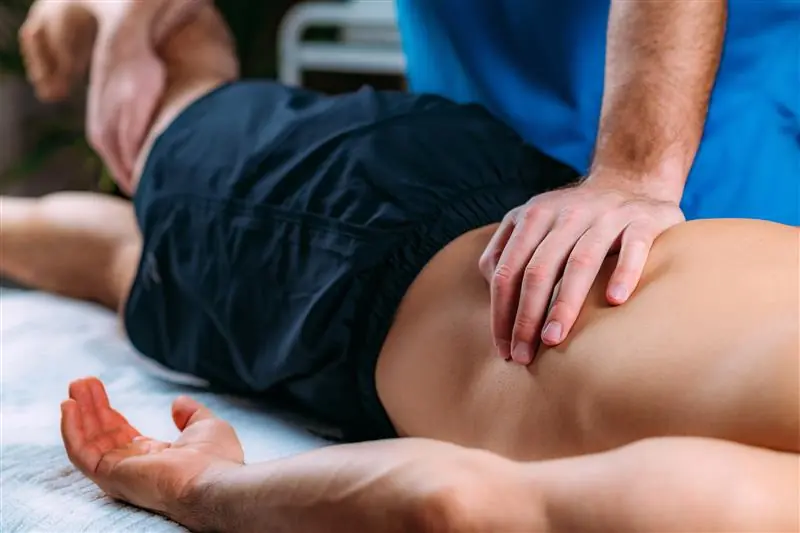Up to two percent of adults each year experience disc herniations. This may lead to pain, numbness, loss of strength, or even no symptoms at all.
As a physical therapist, I’ve seen both ends of this spectrum: patients in terrible pain from a small herniation, and patients with “scary” MRI findings who had no symptoms at all. In this article, I’ll walk through the difference between a bulge and a herniation, the types of herniations, whether discs can heal, how we interpret MRI findings, and the role of physical therapy and surgery.
Disc Bulge vs. Herniation: What’s the Difference and Why It Matters
Before we get into the different types, here are important components that make up and may interact with your spinal discs:
Annulus Fibrosus
- The disc’s outer wall.
- Made of tough, layered fibers – like the strong rubber shell of a tire.
- Job: hold everything in and keep the spine stable.
Nucleus Pulposus
- The disc’s inner center.
- Gel-like center – think of it as the shock absorber that lets the spine handle pressure and movement.
- Job: cushion your vertebrae, act like a mini “ball bearing” for motion.
Nerve Root
- The “wires” that exit the spine and travel into your arms and legs.
- Job: carry signals for movement, feeling, and reflexes.
- Problem: if a disc bulges or herniates into the space where these nerves run, it can pinch or chemically irritate them leading to pain, tingling, or weakness.
A disc bulge means the outer wall of the disc (annulus fibrosus) stretches and pushes outward all the way around, with the inner gel (nucleus pulposus) still contained.
A herniation, in contrast, is a focal defect. One spot weakens or tears, allowing the inner gel to push through in a small area.
Disc bulges are very common, especially as we age, and most don’t cause symptoms. Herniations are less common but more likely to irritate nerves and cause leg or arm pain.

Disc Bulge
- What’s happening: The annulus fibrosus stretches and bows outward evenly, but the nucleus pulposus stays contained. Additionally, bulges are technically not categorized as herniations but are often lumped together.
- Analogy: Imagine squeezing a stress ball so the whole ball balloons outward without breaking.
- Symptoms: Often no symptoms. If a bulge narrows the space for a nerve, it may cause mild nerve irritation.
Disc Protrusion
- What’s happening: Pressure pushes the nucleus harder against one weak spot in the annulus, but the wall remains intact.
- Analogy: One side of a stress ball bulges more than the rest, stretched thin but not torn.
- Symptoms: Potential nerve irritation that may lead to pain, numbness, or weakness.
Extrusion
- What’s happening: The annulus tears, and part of the nucleus breaks through, still connected but hanging beyond the disc.
- Analogy: A stress ball develops a crack and some gel squeezes out, still attached but outside the ball.
- Symptoms: Higher risk of nerve irritation that may lead to pain, numbness, or weakness.
Sequestration
- What’s happening: A piece of the nucleus fully separates and becomes free-floating in the spinal canal.
- Analogy: A chunk of gel breaks off from the stress ball and sits outside on its own.
- Symptoms: Higher risk of nerve irritation that may lead to pain, numbness, or weakness.
Can a Disc Herniation Heal on Its Own?
Surprisingly, yes. Research shows that many disc herniations regress or even disappear over time without surgery. Studies have found that spontaneous regression of herniated discs is common, especially larger ones, due to natural resorption. Some research has shown that around 66% of lumbar disc herniations will shrink or resolve on their own.
In my own clinic, I’ve seen patients frightened by their MRI, only to improve dramatically over months of conservative care. Their follow-up imaging often shows a smaller or even resolved herniation.
Why MRI Results Don’t Always Explain Back or Neck Pain

The chart above shows how common it is to have a structural issue found on an MRI in asymptomatic people. For example, 60% of people in their fifties showed a disc bulge, but had zero symptoms. In other words, findings on a scan don’t always match what you feel.
That’s why a clinical evaluation is so important. Pain, numbness, or tingling can come from many sources, and imaging alone doesn’t tell the full story. A physical exam, movement assessment, and history help connect the dots in a way that an MRI image simply can’t.
Do You Need Surgery for a Herniated Disc?
The first step in treating a herniated disc should almost always not be imaging or surgery. Unless you have major losses in strength, sensation, or bladder/bowel control, the first step is almost always conservative care such as physical therapy. Prematurely getting imaging or surgery can lead to unnecessary costs and worse outcomes.
Some studies have shown that surgery may provide some mild short-term pain outcomes, but long-term outcomes are similar between patients who undergo surgery and those who pursue non-surgical care. That means most people can recover well without needing any invasive procedures.
Key Physical Therapy Strategies to Relieve Herniated Disc Symptoms
Physical therapy focuses on empowering you with individualized strategies, usually focusing on three main pillars:
1. Remove or Modify Aggravating Factors
Many patients feel worse after sitting for longer periods. Simple adjustments like lumbar supports, standing desks, or walking breaks can make a big difference.
In the gym, if certain lifts flare symptoms—like heavy deadlifts — I coach patients on scaling movements or choosing alternatives until symptoms calm down.
2. Choosing The Best Exercise
There’s no single “best” exercise for discs, but staying active is key. Your PT will help identify which exercises to avoid temporarily and which to keep doing, then guide you back to full activity. The key is to work on what you can now, and then as things improve, periodically revisit certain movements that previously caused you pain. Strength training, yoga, aerobic exercise, or any other form of activity is recommended and beneficial to continue doing.
3. Repeated motions for short-term pain relief
If you’re experiencing sciatica-like symptoms in your lower body, certain repeated lumbar movements can sometimes lessen or even resolve the pain. The key is to test how your body responds. Try each of these and notice whether your symptoms improve, worsen, or stay the same:
Extension (Prone Press-Ups)
- Lie face-down on the floor with your hands under your shoulders.
- Gently press your upper body up, keeping your hips and legs on the floor.
- Straighten your elbows as much as comfortable, letting your low back arch.
- Lower back down slowly.
- Repeat 30 times, pausing briefly at the top of each movement.
Flexion (Forward Ball Roll or Sitting Reach)
- Sit on the edge of a chair
- Slowly roll an exercise ball forward, letting your spine gently round and your arms extend in front of you.
- Roll back to the starting position.
- If you don’t have a ball, you can do a similar motion by sitting and sliding your hands down the front of your thighs and shins, then returning upright.
- Repeat 30 times, pausing briefly at the bottom of each movement.
If either of these motions decreases leg pain or makes symptoms feel better, it may be worth performing that movement several times throughout the day. In my clinical experience, most patients with disc-related pain respond best to extension-based exercises, but it’s important to try both directions to see which your body prefers.
How Physical Therapy Helps Relieve Herniated Disc Pain Without Surgery
Disc bulges and herniations are common findings, but they don’t always equal pain or disability. Many herniations heal on their own, MRIs don’t always tell the full story, and surgery is rarely the first step. Physical therapy offers practical tools, movement strategies, and reassurance to help you recover and get back to what you enjoy.
Find a PT Clinic Near You!
Struggling with back or neck pain from a herniated disc? Physical therapy can help you find relief and get back to doing what you love—without surgery or long-term medication. Use our interactive map tool to find a physical therapy clinic near you and start your journey to recovery today!


